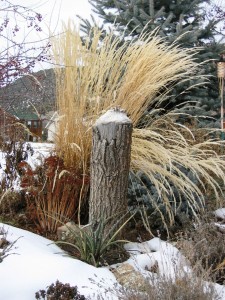Thursday, February 5, 2015
Master Gardeners' Tips for Winter Interests
People tend to associate gardening with springtime around here, but you don't have to be a one-season wonder.
There are plenty of ways to keep you garden interesting even in winter, and Master Gardener Kathy Terrell offered some suggestions when she visited Mentor Library's Main Branch Wednesday.
Different things make a garden interesting during different seasons. In spring, you have everything blooming; in summer, you have verdant greens; in autumn, the foliage.
And what's so beautiful about winter? The leaves have fallen and most of the world is brown and white.
But there are still ways to add color to your garden—even in winter.
For example, some trees have exfoliating bark, which gives them a beautiful dappled pattern in the winter. These include the striped bark maple, lacebark pine, franklinia and cornus kousa. Sycamores have pretty green and white streaks. It's a way to add subtle, pretty color to that white and brown winter world.
Of course, evergreens like Holly trees, blue spruces (which make great hedge rows,) dragon eye pine (with their variegated needles) or Washington hawthorns can add splashes of blue, green, yellow and even red, respectively, to your yard. Red or yellow twig dogwoods also provide their namesake colors even after their leaves have fallen.
Additionally, you can also add color with shrubs like the variegated yucca or partridge berry and early bloomers like hellebores or witch hazel. (Just be careful that your ground covers, whatever they may be, don't creep across your whole yard.)
By the way, winter also reveals a different aspect of your garden than other season—its structure. The "skeleton" of a tree can be just as captivating as its foliage or flowers, if in a different way. For example, river birches form handsome clumps; dawn redwoods evoke pyramids; weeping hemlocks can add depth to your garden; and espaliered crabapples can make a beautiful border. (Remember, when planting a tree, plan for its mature size. You don't want roots cracking your foundation.)
And complement your trees' "bones" with serviceberries, rhododendrons, grasses or a Turkish Filbert (which is great for flower arrangements, as well, in the summer.) Of course, if you get enough snow, you may not be able to see them for a week or eight.
After all, the idea of a winter interest isn't to recreate spring in the winter. That's impossible. It's purpose is to highlight winter's own beauty.
The master gardeners will return to Mentor Library's Main Branch on Wednesday, March 4, to recommend perennials that can give your garden year-round color. If you have any questions, you can visit their website and ask for help there.
Subscribe to:
Post Comments (Atom)

No comments:
Post a Comment